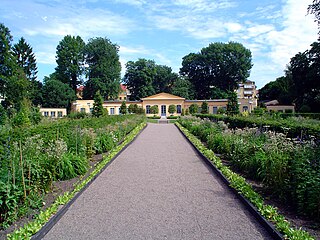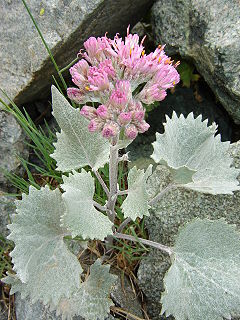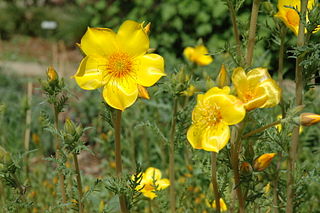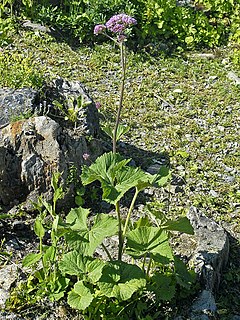
Bidens is a genus of flowering plants in the aster family, Asteraceae. The common names beggarticks, black jack, burr marigolds, cobbler's pegs, Spanish needles, stickseeds, tickseeds and tickseed sunflowers refer to the fruits of the plants, most of which are bristly and barbed, with two sharp pappi at the end. The generic name refers to the same character; Bidens comes from the Latin bis ("two") and dens ("tooth").
In biology, trinomial nomenclature refers to names for taxa below the rank of species. These names have three parts. The usage is different in zoology and botany.

The International Code of Nomenclature for algae, fungi, and plants (ICN) is the set of rules and recommendations dealing with the formal botanical names that are given to plants, fungi and a few other groups of organisms, all those "traditionally treated as algae, fungi, or plants". It was formerly called the International Code of Botanical Nomenclature (ICBN); the name was changed at the International Botanical Congress in Melbourne in July 2011 as part of the Melbourne Code which replaced the Vienna Code of 2005.

Adenostyles is a genus of flowering plants in the sunflower family Asteraceae, and of the tribe Senecioneae. It was described as a genus in 1816. Adenostyles occur in the temperate climates of the northern hemisphere, mainly in Europe and Asia Minor.

In botanical nomenclature, a form is one of the "secondary" taxonomic ranks, below that of variety, which in turn is below that of species; it is an infraspecific taxon. If more than three ranks are listed in describing a taxon, the "classification" is being specified, but only three parts make up the "name" of the taxon: a genus name, a specific epithet, and an infraspecific epithet.

Antennaria is a genus of herbaceous perennial plants in the family Asteraceae, native to temperate regions of the Northern Hemisphere, with one species in temperate southern South America; the highest species diversity is in North America. Common names include catsfoot or cat's-foot, pussytoes and everlasting.

A botanical name is a formal scientific name conforming to the International Code of Nomenclature for algae, fungi, and plants (ICN) and, if it concerns a plant cultigen, the additional cultivar or Group epithets must conform to the International Code of Nomenclature for Cultivated Plants (ICNCP). The code of nomenclature covers "all organisms traditionally treated as algae, fungi, or plants, whether fossil or non-fossil, including blue-green algae (Cyanobacteria), chytrids, oomycetes, slime moulds and photosynthetic protists with their taxonomically related non-photosynthetic groups ."
Nomenclature codes or codes of nomenclature are the various rulebooks that govern biological taxonomic nomenclature, each in their own broad field of organisms. To an end-user who only deals with names of species, with some awareness that species are assignable to families, it may not be noticeable that there is more than one code, but beyond this basic level these are rather different in the way they work.
The International Code of Nomenclature for Cultivated Plants (ICNCP), also known as the Cultivated Plant Code, is a guide to the rules and regulations for naming cultigens, plants whose origin or selection is primarily due to intentional human activity. Cultigens under the purview of the ICNCP include cultivars, Groups, and grexes. All organisms traditionally considered to be plants are included. Taxa that receive a name under the ICNCP will also be included within taxa named under the International Code of Nomenclature for algae, fungi, and plants, for example, a cultivar is a member of a species.

Arnoglossum is a North American genus of plants in the sunflower family, described as a genus in 1817. They have the Common name Indian plantain because they resemble the unrelated common plantain.

Packera is a genus of about 64 species of plants in the composite family, Asteraceae. Its members were previously included in the genus Senecio, but were divided out based on chromosome numbers, a variety of morphological characters, and molecular phylogeny.

Astereae is a tribe of plants in the family Asteraceae that includes annuals, biennials, perennials, subshrubs, shrubs, and trees. Plants within the tribe are present nearly worldwide divided into 170 genera and more than 2,800 species, making it the second-largest tribe in the family behind Senecioneae. They are found primarily in temperate regions of the world.

Mentzelia is a genus of about 60-70 species of flowering plants in the family Loasaceae, native to the Americas. The genus comprises annual, biennial, and perennial herbaceous plants and a few shrubs.
Authors of Plant Names by Richard Kenneth Brummitt and C. E. Powell, 1992, is a print database of accepted standardized abbreviations used for citing the author who validly published the name of a taxon. The database is now maintained online at the International Plant Names Index. The book provides recommended abbreviations for authors' names that help to distinguish authors with the same surname when giving the full name of a taxon. It deals authors who validly published the name of a flowering plant, gymnosperm, fern, bryophyte, algae, fungi or fossil plants. Prior to its publication in 1992, many abbreviations for authors to be cited could be found in Taxonomic literature. A selective guide to botanical publications and collections with dates, commentaries and types. by F. A. Stafleu & R. F. Cowen, 1976–1988.

Adenostyles alliariae is herbaceous perennial plant belonging to the genus Adenostyles of the family Asteraceae.

Cranfillia fullagari, synonym Blechnum fullagarii, is a fern in the family Blechnaceae. The specific epithet honours James Fullagar, who collected plants on Lord Howe Island for the Royal Botanic Gardens, Melbourne.
Arnoglossum sulcatum is a North American species of plants in the sunflower family. It is native to the southeastern United States in the states of Mississippi, Alabama, Georgia, and Florida.

Arnoglossum reniforme is a North American species of plants in the sunflower family. It is native to the central and east-central United States primarily in the Appalachian Mountains, the Ohio/Tennessee Valley, and the Mississippi Valley. There are additional populations in the east and farther west in Oklahoma.













